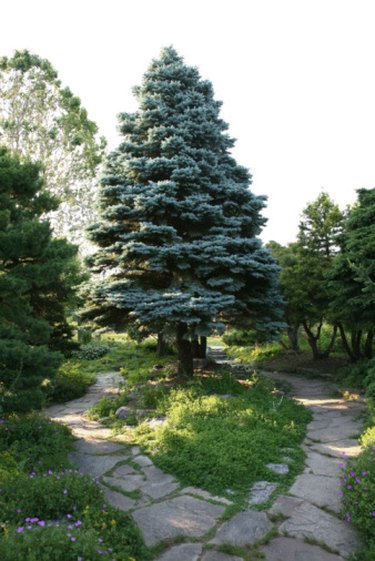
Spruce trees – and other evergreens – are susceptible to attack by boring insects, those that tunnel beneath the bark and feed on the wood underneath. Stressed trees are far more susceptible to attack than healthy trees are. The best prevention for borers is to keep trees healthy and to grow only those trees that are well suited to your climate.
Types
Video of the Day
Different types of borers, not all of which are fatal to the tree, attack spruce trees. Flathead fir borers (Melanophila drummondi), pine shoot borers (Eucosma sonomana), ips beetles and white pine weevil (Pissodes strobi). Damage from the white pine weevil and ips beetle usually isn't fatal, but over generations, the ips beetle can cause the tree to die.
Video of the Day
Damage
Borers, as their name suggests, bore into the wood of the tree as larvae. They damage the sap system of the tree – the xylem layer beneath the bark, which is responsible for transporting water and nutrients throughout the tree. As they tunnel through the tree, they can girdle it completely, thereby halting the flow of nutrients to the upper parts of the tree. This causes the tree to die. Sometimes the whole tree is affected, but the pine weevil, for example, only causes deformation of new growth and results in dead needles.
Detection
Look for holes in the tree and signs of tunneling. The most common sign is sawdust around the borer hole or around the base of the tree. A hole full of sawdust indicates the larvae are still beneath the bark, while an empty hole indicates that the adults have left the tree. Check new spruce growth for tiny, pinpoint holes oozing pitch, which indicate the presence of white pine weevils. Flathead fir borers leave no indication of their presence until the tree is weakened severely. They, however, prefer trees already damaged by fire or other stress, or even trees that have already died.
Treatment
It is extremely difficult for the homeowner to treat borers with insecticides, as timing is critical and requires consistent monitoring of the affected tree. Apply insecticide after the larvae hatch, but before they tunnel into the bark, as they are impossible to kill once they enter the tree. Small infestations of weevils can be treated by removing and destroying the affected branches, but severe infestations of other borers are very difficult to treat; instead, the tree should be cut down to prevent the pests from spreading.
- Montana State University Extension; Tree Borers; Sherry Lajeunesse; September 1997
- Montana State University Extension; Growing Spruce Trees in Montana; Martha Mikkelson, et al.; March 2005
- Oregon Department of Forestry; Flathead Fir Borer; July 2007
- Colorado State University Extension; Ips Beetles; W. Cranshaw, et al.; December 2002
- University of Idaho Extension; Protecting Against Tree Borers; May 2010